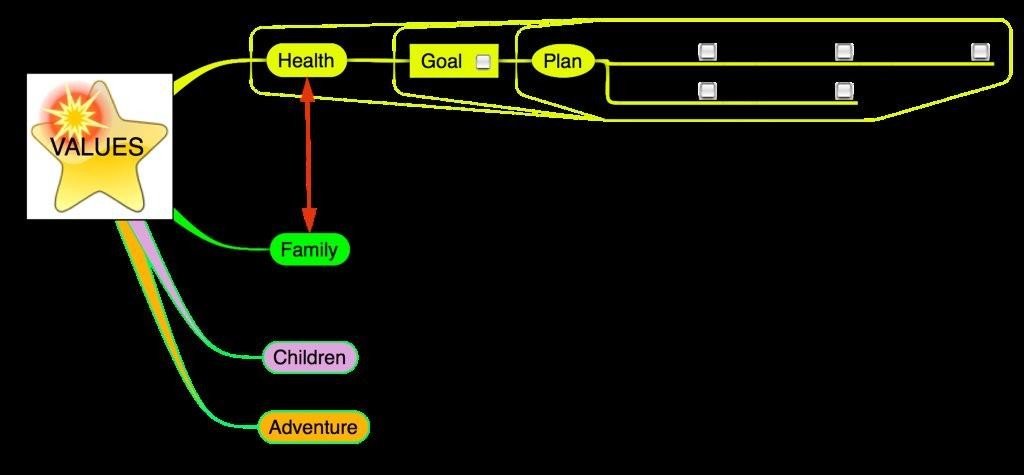Life by Design: Harnessing Values to Create Motivation in Your Patients
Rick Brinkman, ND
Since naturopathic medicine is about looking at the whole person, in this article we’ll examine how having clear values, goals and plans can dramatically affect depression or low energy, and how you can use values to motivate patients to follow through on your recommended treatment and lifestyle modification plan. My practice, both private and public (seminars and training) have focused on the mental/emotional levels of wellness.
My first awareness of holistic medicine dates back to 1976 when I was on an open-ended cross-country trip originating in New York City. I had traveled 17 000 miles and 3.5 months when I met a guy in a park in Eugene, OR who told me about naturopathic medicine and a school called NCNM, in Portland. I had graduated Premed and was on this trip as a break before applying to medical schools. The next day I checked out NCNM and although I hadn’t previously heard of naturopathic medicine, I knew it was the kind of medicine I wanted to practice. As fate would have it, NCNM had one space left in the class because of someone not showing up, I had all the requirements in place, and they said, “You can start next week.”
This required a quick trip to Wichita, Kansas, where NCNM held its first 2 years of instruction. Suddenly I am in my first class and meeting my first ND, Dr Hulbert, who draws two stick figures on the board. He says, “What you see before you are the two kinds of disease in the world: horizontal disease and vertical disease. In horizontal disease, a person doesn’t function. It could be life-threatening, or not. Both a heart attack and a bad flu are horizontal. But the good thing about horizontal is that it gets your attention, so you do something about it. With vertical disease, people can feel miserable but are functional, as in arthritis, metabolic syndrome, high blood pressure, etc. Most disease is vertical before it goes horizontal. Our goal as naturopathic physicians is to take people from where they are and move them to optimal health, quality of life.”
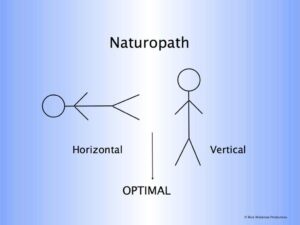
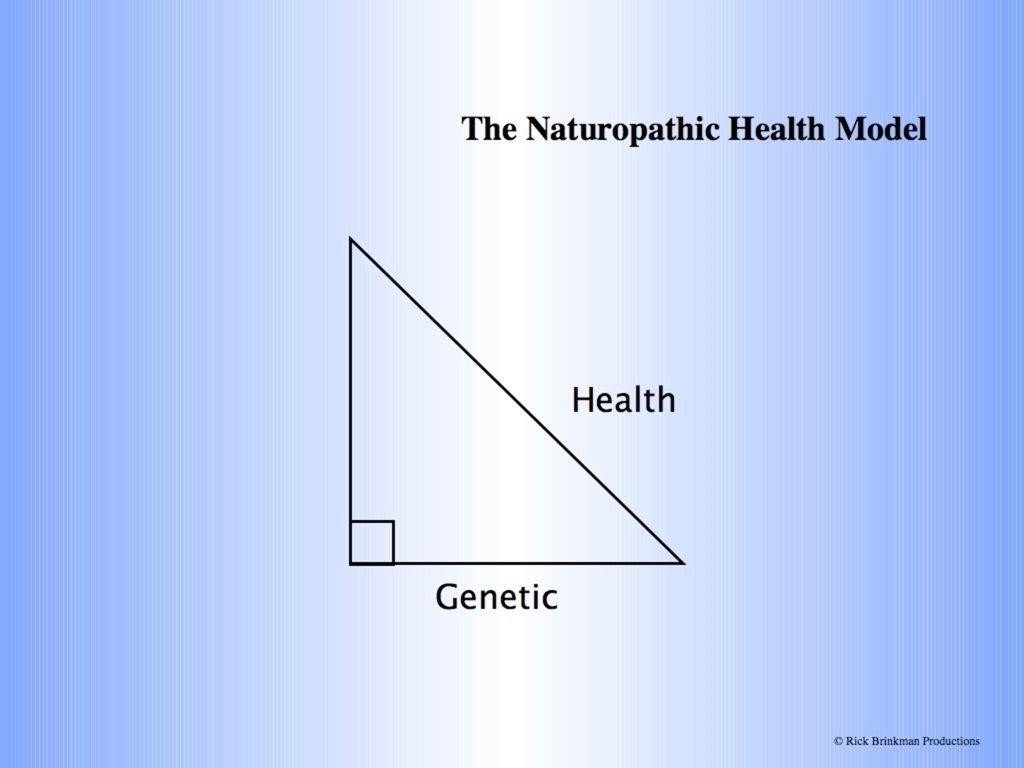
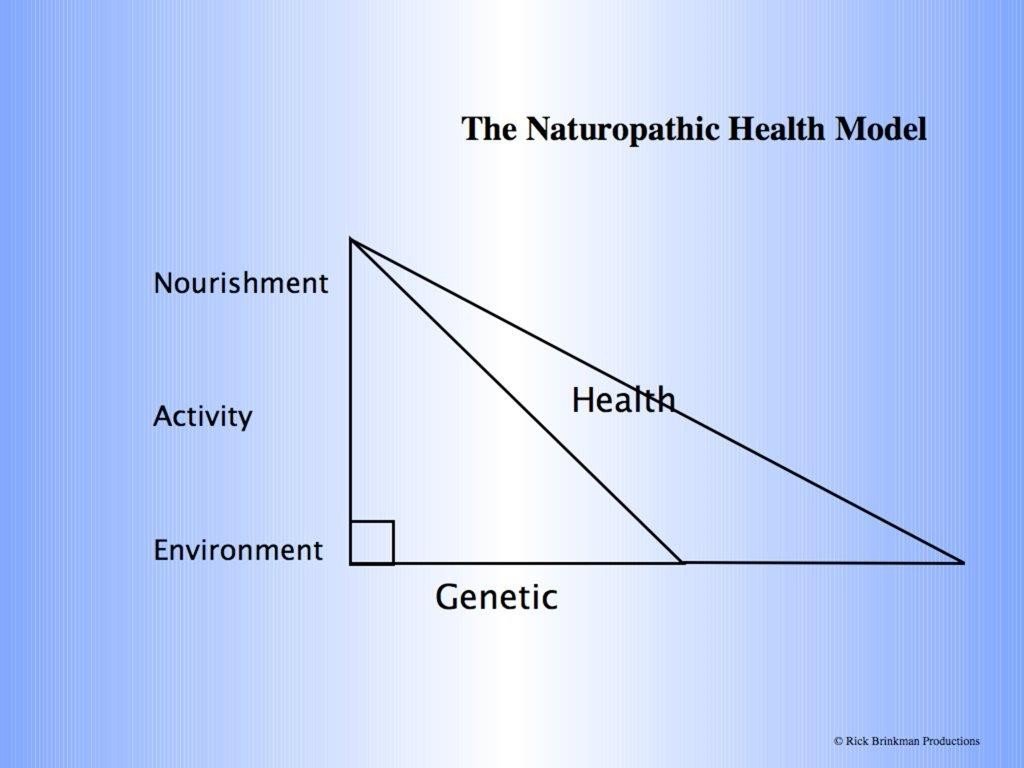
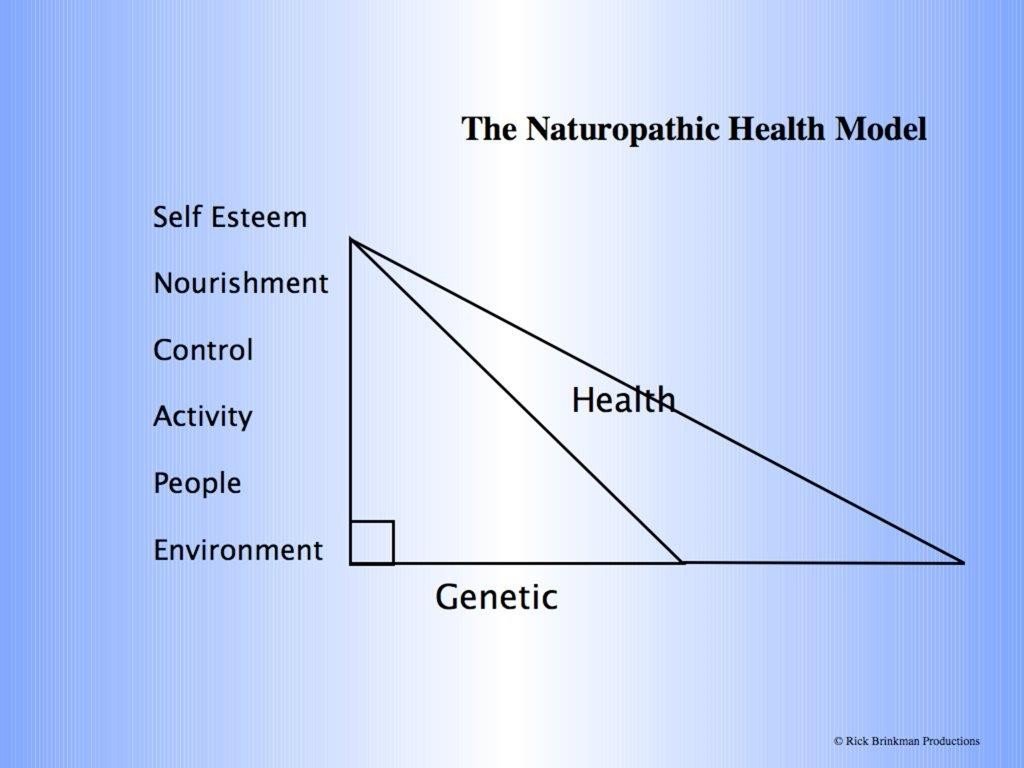
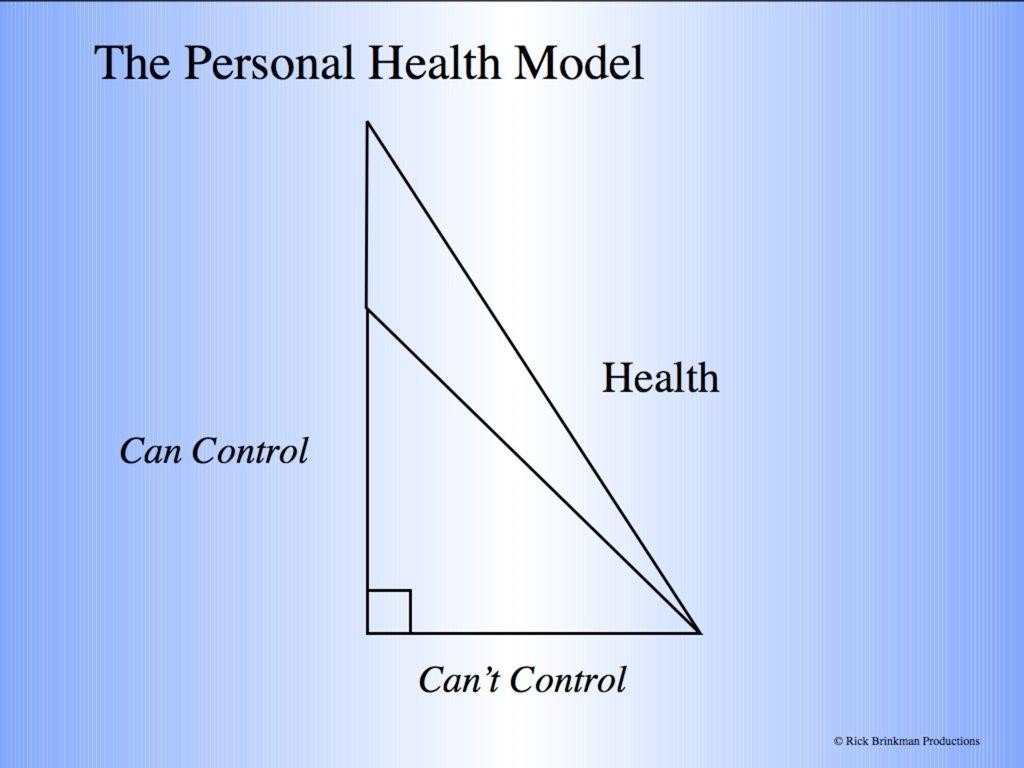
The longer that line is, the healthier you are. So, as I’m sure you remember from basic geometry, the way you make a hypotenuse of a right triangle longer is to increase the length of the base or the length of the height. But the base represents our genetics, which at this point is still fixed. People bring into the world strengths and weaknesses. Eyesight is an obvious example but it’s true in every organ system, in our biochemistry, and even in our attitude. Any parent can attest to how their children came into the world with “a certain attitude.”
Some people bring in so much genetic strength on so many levels, they have a pretty significant degree of health, no matter what else they do. George Burns, for example, lived to be 100, was totally functional, and smoked 18 cigars every day. When asked, “What do your doctors say about that?,” he replied, “What can they say? They’re all dead.”
The vertical line in the triangle represents our choices. On a physical level we make choices about what we eat, about our level of activity and exercise, and about our environment, in terms of where we live, what we breathe, etc.
Four years and a year-long residency later, I was in private practice and had a “hopeless case.” I had a patient who had arthritis for 15 years, had tried everything traditionally and alternatively, and nothing had worked. So I asked her what was going on in her life. I found out that her husband worked for the federal government and flew back and forth to Washington DC each week. She hated that job for 20 years but hadn’t expressed it because she wanted to support him. When a minor upset occurred, she wouldn’t deal with it, since they only had a weekend together. He was supposed to take an early retirement but decided against it and she suppressed her feelings about that too. If you suppress too much with someone you care about, it creates a barrier between the two of you. My entire prescription was to teach her how to share upset without the other person feeling attacked. She pulled it off, and 30 days later her symptoms were gone.
I continued to dig deeper into the mental/emotional lives of my patients and before I knew it, my whole practice was referral-based for mind-body medicine. And finally, in a blinding flash, I realized the obvious. Of course it counts what you eat, but there’s more to you than your physical body. Nourishment on a mental/emotional level can be self-esteem. How good you feel about yourself also determines how well you take care of yourself physically. Activity is not just about exercise, but also the degree of control you feel over your life. The degree to which you fulfill values and goals that are important to you is the degree to which you have health at this level. Environment isn’t just the air we breathe, but is also (and especially) the people that surround us. Ever notice how a difficult person can pollute the environment?
Sorting Out What Can and Can’t Be Controlled
You can make the hypotenuse of the health triangle represent any goal you want: changing one’s diet, having a new career, etc. Whatever the goal, immediately sort into two kinds of factors: those you can’t control (genetics), and those you can control. It’s important to recognize what you can’t control, while not dwelling on it. However, the most success in life comes from maximizing that which you can control.
This article is about that part of our health triangle that relates to the degree of control we feel over our lives. I have found a direct correlation between depression or low energy and the lack of feeling in control and/or lack of fulfillment.
To be in control, the first thing we must realize is that all we have is right here, and now. As you read this, it’s ‘now.’ When you woke up this morning, it was ‘now.’ When you finish reading, this will still just be here and ‘now.’ I don’t mean to get too metaphysical with you, but you’re readers of NDNR and I am sure you can handle the truth. All we ever have is right here and ‘now.’ The future is filled with possibility and there are many events/activities/people that will be asking for our attention in the ‘now.’ Not all events will fit. Whatever you accept into your ‘now,’ in the blink of an eye becomes the past. If your choices are based on your highest priorities, then you feel fulfilled when you look to the past. If your choices are based on random priorities or the priorities of others, you’ll look to the past and feel regret. The name of the game is being in charge of your ‘here and now.’ Every time we say “yes” to something in the ‘here and now,’ we are saying “no” to a whole lot more. And though at first it can be hard to say “no” to certain things, when you are crystal clear about what you want to say “yes” to in life, it becomes easier to say “no.” Steve Jobs said, “The things I’m most proud of are the things I said no to.”
Values, Goals and Plans
To make sure we are fulfilling our highest priorities, we need to create a screen for our now-moment, a filter, so to speak, to weed out certain events and only allow in our highest priorities. There are 3 parts to the filter: a person’s values, goals, and plans.
Values are generally highly important categories. We all have values within us, whether or not we are conscious of them. Goals are specific objectives that are measureable and have a date. And a plan is a series of small action steps that leads you from where you are to where you want to be (the goal).
If you consider ‘success’ to be accomplishing whatever you set out to do, work backwards from there, and you’ll see that what precedes success is action. It is at this level where we have to face procrastination. We’ll cover that in this article … later. Before we can act, we have to know what we’re going to act upon. That’s where the plan comes in, since a plan is a series of action steps that take you from where you are to where you want to be. Before you make the plan, you need to know where you want to be, and that’s the goal.
I have found two primary reasons for why people set goals and don’t achieve them. Either the plan is not specific enough, or the goal is not rooted in values.
Clarifying Values
Let’s begin with values, as they are our foundation, and the violation of one’s values is a common cause of distress or dis-ease. How do you clarify values? I found the simplest and most efficient way is to just come up with a list of words that represent one’s highest priorities. Some greatest hits I would hear in practice were: God/Spirit, Family, Children, Health, Career, Love, Friendship, Honesty, Integrity, Fun, Adventure. Notice that the majority of these words are categories. Family and Health, for example, are categories. But some are qualities, like Honesty or Integrity. Some people have more qualities, while others have more categories. There is no right answer. It simply is what it is. The same thing is true with values. Some people have 5 while others might have 10. It is what it is.
Note that as a physician, your patients are coming to you because they probably have a value related to health. Or maybe health is important because it connects to their highest value of Family, to be there and provide for them. You can leverage this to have people act on your recommendations.
Clarifying values is not just for individuals. It works great for teams of people. You can do this in your clinic with your whole staff. In that case, I would recommend that you try to keep the values to 5 or less words and ideally create an acronym. One clinic I worked with came up with “H.E.A.L.”
As individuals, we have different sets of value sets. One is for our whole life. Then there are subsets for career being a parent, relationships, etc. The subsets must fit into the ‘whole life’ set. In general, with patients I clarify their ‘whole life’ set and then do specific subsets if there are significant transitions occurring in that area, ie, they are looking for a new career, they are getting divorced, getting into a new relationship, having children, etc.
Once a person has written the words, the next step is to define those words in two sentences or less. During this process, people sometimes discover that two of the words are really one category, and the words merge. Other times, a word might split into two words representing two different values. It may only take 10 minutes to do this process, but at that point, people tend to have some big “ah-ha’s.” I had a patient once who had Honesty and Integrity as her values and then she realized that every day she went to work and sold something she didn’t believe in. When she quit that job, she not only became more happy and successful, but her tumors disappeared.
After defining values, the next step is to put them in order of priority.
Another patient had Family, Health, Work as his values, in that order of priority. When he consciously faced his values, he realized he was spending the majority of his time on career, and although he did take time to be with family, specifically with his children, he was very distracted by his work. He also was not giving himself permission to take time to do the things that would support his health, like exercising.
But once he externalized those values and became conscious of them, he became more present and balanced. That same amount of ‘children time’ became purely focused time. Suddenly he was able to give himself permission to take the steps necessary to maintain his health, especially since he saw how, in the long term, doing this tended to cycle right back into Family and Children, by being alive and healthy for them. Becoming present in the moment, and having perspective, are often the instant results of clarifying values.
I had a patient who came to me saying he “had depression.” Here’s a quick grammar lesson. Depression is a noun; it’s a thing. A thing is here today and here tomorrow. Whereas “to be depressed” is a verb, which makes it a process. A process evolves through time. Allopathic medicine tends to turn verbs into nouns. “It”, the disease, is something you have, something you ‘got’ and which should be medicated or cut out. But disease is a process; you’re sick today, you do what it takes to get well, and you’re better tomorrow. Mental “disease” like depression is the process of ‘being depressed.’ Thinking holistically, I want to turn my patient’s noun/thing back into a verb/process; therefore, I ask, “What are you depressed about?”
He said he had been through 2 years of psychoanalysis and at the end of 2 years of analysis, the conclusion was, “You’re depressed— take this pill.”
But then he became more depressed because the medication was not working, and he didn’t realize he was violating a personal value of Health by being on medication.
I asked him what was going on in his life. He said he was in a dead-end job that was going nowhere. I asked about his past. He said, “Filled with failure.” I asked how he saw his future and he said, “More of the same.”
That’s pretty depressing, don’t you think? Here’s a quick strategy to bum yourself out, just in case you ever get too happy… Pick something in your present that you don’t like and visualize it continuing into the future. You will immediately feel bad. The good news is that the process also works in reverse. If there is something in your present you don’t like, but are taking action in the present to change the future, you will already start to feel good. When you are with a patient addressing a health issue, and you clearly connect the dots between the present and how the actions you prescribe take them to a better future, they will already feel good and be more likely to take action to follow your advice.
Another patient came to me because of her boss that was “driving her crazy.” After clarification, we found that two of her high-level values were Children and Education. As a result, it was a top priority for her to provide an education for her children. She suddenly had the “ah-ha” moment. She was feeling trapped in her job, hating the present with her boss, and seeing more of it in the future. But the only reason she needed to stay in this job was to put her two daughters through college. In 3 years, the second daughter would be out of college and she could leave that job if she wanted to. Like magic, her boss didn’t seem like such a big deal. She was consciously clear about what she was saying “yes” to and felt fulfilled with the satisfaction of what she was accomplishing.
Human beings can only consciously pay attention to 7 things, give or take 2, at any one time. A part of our brainstem is the reticular activating system, and one of its many functions is radar. If you get married, you see everyone getting married. If you’re having children, there appears to be a baby boom. If you’re interested in a certain car, you see it all around you. Before my patient came to me, her 7 bits of attention were consumed by the boss and a feeling of being trapped. Once her conscious attention was filled with what she was accomplishing at a high value level, it was a healing for both her mental and emotional body, and subsequently her boss’ behavior no longer bothered her.
By clarifying values into a simple list of words, you trigger the reticular activating system to notice and take action.
The process is:
1) List words to represent the highest values.
2) Define those words in two sentences or less. Let words merge or split.
3) Put the words in order of priority.
4) Print and post them, to trigger the reticular activating system.
This is something you can do with your patients quickly. Ask them why they value their health. It may seem to be just for health’s sake but it usually connects to the fulfillment related to other high-level values. And just like that, you’ve plugged in to a very deep motivation. Then set a goal with them for their future and really describe what is possible for them. Next connect the dots between your treatment plan, the actions they will take in each moment of ‘now,’ and how it will become the positive future.
In general, I think it’s a good idea to re-clarify values once a year and definitely when going through a major transition, eg, having children, getting divorced, starting a new relationship, looking for a new career, etc. In such cases, you would not only clarify the life values, but also the values for the specific life transition, like relationship values or career values.
Once people clarify values, it’s useful to do a quick values analysis. I ask people to review the last 7 days and consider any action they have taken that fulfills those values and put a put check mark next to it. Often people will discover that they are taking action but weren’t consciously appreciating it. Conscious appreciation is important. It is renewing and energizing. A person could be depressed because their 7 bits of conscious attention are focused on what is not getting done. That sends them into a downward energy spiral. When they see the things they are accomplishing, it puts them into a positive spiral.
For the values with few check marks, where they are not taking action, I ask them to look to the future 7 days and brainstorm possible actions they will take to fulfill those values. If you are doing this with a patient at the end of a visit that is related to health, some of those actions will probably be the very steps you recommended to them. Mentally visualizing helps plant the seeds of action.
The purpose of having clear values is to get our reticular activating system focused on the ‘now,’ in order to take action on the highest priorities.
Planting Goals
Getting values into place provides a fertile ground in which to plant goals. A goal is an objective that has some specific qualities that make it functional:
- It is measureable
- It has a date
- It is written
I had a patient who wanted to lose weight. Her measurable goal was to be able to walk around Disneyland in June with her grandchildren. (The actions she would take on a daily basis to achieve this goal constituted the “Plan”.)
Goals can be external or internal. A patient wanting to accomplish a 7K run is an external goal. Having the mental discipline to train is an internal goal. A measureable sub-goal might be, “I am running 5 times each week.”
A goal must be written such that it will trigger the reticular activating system to notice resources that support the goal’s success and the opportunities to take action. Suddenly people are not forgetting to take supplements, or to set the alarm to get up to run.
Creating A Plan
Once Values and Goals are in place, the next step to make a Plan. A plan is a series of action steps that lead you from where you are now, to where you want to be. They are the mundane simple actions that are taken in each moment of ‘now.’ I find it best to represent a plan with a mind-map. That allows people to see the big picture and the proverbial ‘bird’s eye view’ of what they are trying to accomplish. Having that perspective keeps people out of overwhelm. With a patient you can create a ‘health map.’ You can certainly draw it on a piece of paper, or have them draw it. Or you can use mind-mapping software, which is my preference. My favorite software is Nova Mind. It costs $99 for Mac and Windows. For the iPad, the software is iThoughtsHD, which can also share files with Nova Mind.
The actions in a plan must be so specific that there is no doubt what a person is going to do and when they will do it. Having a clear plan of action represented by everyday simple steps will address the major reasons that people procrastinate. One of the most common reasons for procrastination is that a task is so big or complex that people don’t know where to start. A plan addresses this problem by breaking down the big task into simple, small steps that are taken in each moment of ‘now.’ Another reason people procrastinate is fear of failure, but when you break something down to simple actions that, too, is addressed. A third common reason for procrastination is that people don’t know where to start. In this case, the plan tells them exactly the next simple steps to do that will lead them on their path of wellness.
Early on in practice (1980s) I remember feeling that taking notes in the chart was a barrier between the patient and myself. One day, on a whim, I got up and instead took notes on my whiteboard, which the patient could also see. I noticed two things: one was that the note-taking was a lot more efficient and complete because the patient had an immediate feedback loop that allowed them to see what they’d told me and what they still needed to tell me. And, in addition, they felt that I really understood their situation. The more people feel like you understand, the more likely they will follow your advice.
But here is the other thing I noticed… In a few minutes, we had filled my whiteboard with this patient’s problems. He looked at it and said, “Wow, look at that. The IRS is after me, my business is failing, I’ve got relationship issues and these 3 health problems. No wonder I’m stressed out. Thanks Doc, I feel much better. How much do I owe you?” And I said, “Wait, that wasn’t the therapy. That was just the note-taking.” But I found that when people see the big picture, it’s therapeutic.
By creating a big-picture action map of your patient’s road to wellness, you will connect the dots from little actions to their bigger goals and values, and this process creates motivation to follow through. You’re giving them perspective, so they can already feel good while they’re doing it. And by leaving your office with a written health map of values, goals and action-plan, it is more likely that in the days and weeks to come, they stay on course in each moment of ‘now.’
 Rick Brinkman, ND is a 1980 graduate of NCNM and best known for his Conscious Communication® and Life by Design expertise conveyed to millions of people via keynotes and trainings. His clients have included: the Astronauts at NASA, LucasFilm, Carolina Healthcare Systems and many more. Dr. Brinkman is the coauthor of five McGraw Hill books that have been translated into 27 languages including Life by Design, and Dealing With People You Can’t Stand.
Rick Brinkman, ND is a 1980 graduate of NCNM and best known for his Conscious Communication® and Life by Design expertise conveyed to millions of people via keynotes and trainings. His clients have included: the Astronauts at NASA, LucasFilm, Carolina Healthcare Systems and many more. Dr. Brinkman is the coauthor of five McGraw Hill books that have been translated into 27 languages including Life by Design, and Dealing With People You Can’t Stand.



